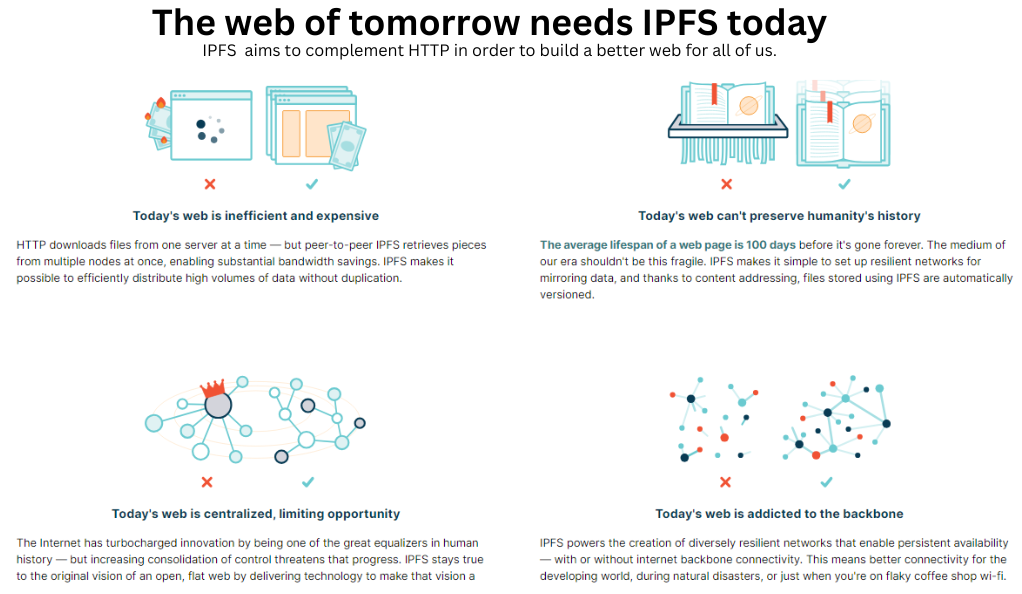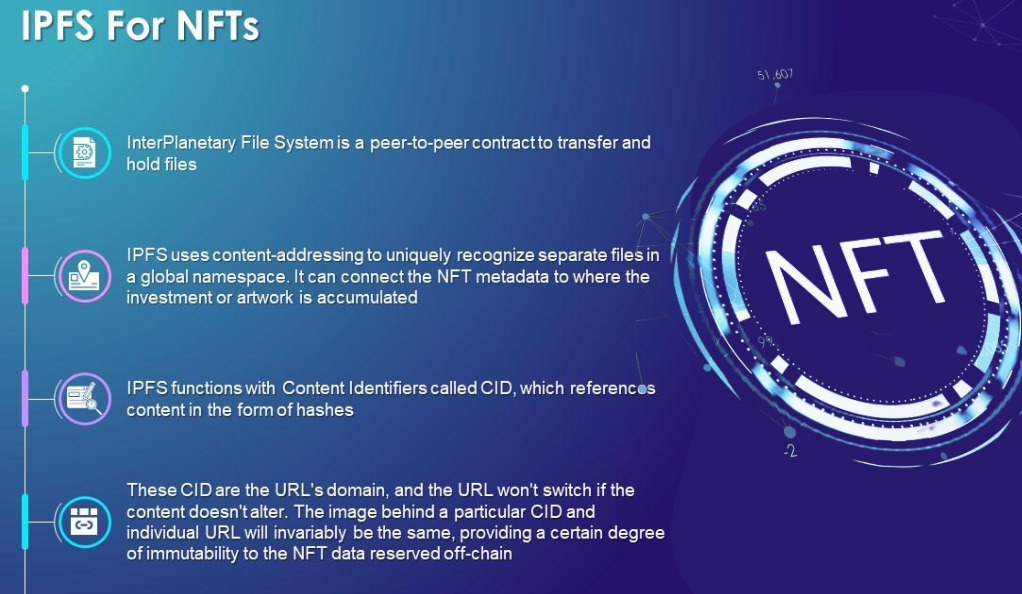Ever wondered what makes the world of Non-Fungible Tokens (NFTs) tick? Or, how it ensures the permanence of the precious digital assets you’ve purchased? Enter InterPlanetary File System (IPFS), the dark horse enabling NFTs’ durability and value preservation. In this era of digital disruption, understanding the nuts and bolts of these innovative technologies can be a game-changer.

NFTs, unique digital assets changing the face of ownership, are being extensively used in fields ranging from digital art to virtual real estate. But what makes them truly unique is their permanence, a feature primarily ensured by IPFS. This revolutionary protocol and network are crucial to understanding NFTs’ functioning, their advantages, and their potential challenges.
Deciphering the Cryptic World: NFTs and IPFS
Understanding NFTs
NFTs are unique digital assets that represent ownership of a specific item or piece of content. Unlike cryptocurrencies like Bitcoin or Ethereum, which are fungible and can be exchanged on a like-for-like basis, NFTs are unique and can’t be swapped similarly. They are stored on a blockchain, a form of distributed ledger, which ensures that every NFT is different and possesses a distinct value.
The attraction of NFTs is their uniqueness, providing digital ownership rights to unique items or content. This has opened up unprecedented opportunities in the digital art world, gaming, collectibles, and even real estate. Anyone can own an NFT, and thanks to blockchain technology, the ownership can be unequivocally proven.
Grasping IPFS
IPFS, on the other hand, is a protocol and network designed to store and share data in a distributed system. The magic behind IPFS is its ability to ensure content remains accessible even when the original publisher is offline. It’s like a giant, distributed filesystem, making the web faster, safer, and more open.
It’s more than just a protocol; it’s a revolution for the internet as we know it. Unlike the traditional web, where information is stored in centralized servers and accessed via locations (URLs), IPFS stores information based on what something is (content-addressing), not where it’s located. This feature enables the immutability and permanence crucial for NFTs.
The Nexus Between NFTs and IPFS
How NFTs use IPFS
Typically, the metadata of an NFT, which contains the detailed information about the digital asset, including the owner, the description, and the image or content itself, is stored using IPFS. When an NFT is minted, it’s permanently linked to this IPFS-stored data. In a nutshell, IPFS gives every NFT a unique, unalterable fingerprint.
This unique fingerprint is vital to the functionality of NFTs. It proves the authenticity of the asset and ensures that the data related to it can’t be manipulated. Without this, the NFT would lose its most significant advantage: the ability to demonstrate provenance and ownership.
Advantages of IPFS for NFTs
Leveraging IPFS comes with multiple benefits. For one, it ensures the immutability and permanence of digital assets, meaning once you own an NFT, the content it represents cannot be altered. Also, it eliminates the need for a central server, enhancing security and resisting censorship. With IPFS, your NFTs are not just unique but also safe from alterations or disappearances.
IPFS also increases the efficiency of data storage and retrieval. By storing data across a distributed network, it reduces the reliance on a single point of failure. This can significantly enhance the performance of NFT platforms and applications, ensuring smoother, faster transactions.
Potential Challenges of IPFS in NFT Storage
While IPFS’s role in NFTs is invaluable, it isn’t devoid of challenges. There’s the question of long-term data persistence, as IPFS does not inherently ensure data stored is kept indefinitely. This issue has led to the rise of services like Filecoin, aiming to incentivize data preservation. In essence, while IPFS ensures that data isn’t lost, it doesn’t guarantee that it’s stored forever.
Besides, as the size of stored data increases, managing it efficiently can become an issue. It’s here that advanced solutions, such as sharding or partitioning, come into the picture. These approaches divide data into smaller, more manageable parts, helping optimize storage and access speeds.
Case Studies: IPFS and NFTs
Decentraland: A Virtual Realm
Decentraland, a virtual reality platform on the Ethereum blockchain, leverages IPFS for storing its NFT data. This data includes descriptions and images of virtual lands, avatars, and other items. Thanks to IPFS, Decentraland can offer a persistent, immutable virtual world where land and assets are truly owned by the users.
The use of IPFS by Decentraland showcases how IPFS can provide a robust, decentralized storage solution for NFT-based platforms. It ensures that the virtual world remains intact, irrespective of the original publisher’s status, providing a truly decentralized experience.
IPFS’ Role in CryptoArt
Similarly, many CryptoArt platforms use IPFS for storing digital artwork, providing artists with the assurance that their artwork will remain intact and available for viewing and trading. Crypto artists can rest easy knowing that their work, once uploaded and turned into an NFT, will persist for as long as the IPFS network exists.
Not only does this protect artists’ rights, but it also opens up new avenues for them to monetize their work. With IPFS ensuring the permanence and immutability of their artwork, artists can sell their work with confidence, and buyers can own a piece of digital art knowing it’s truly theirs.
Looking Ahead: The Future of NFTs and IPFS
As the NFT market continues to grow, so will the use of IPFS. With advancements in technologies like Filecoin, ensuring the permanence of IPFS data, we’re likely to see even more robust solutions for NFT storage and maintenance. Additionally, as IPFS becomes more mainstream, its integration with other emerging technologies such as decentralized finance (DeFi) will undoubtedly fuel further innovations in the NFT space.
While we can’t predict the exact trajectory of NFTs and IPFS, it’s safe to say they’re on a path to becoming increasingly intertwined. As more people embrace the world of NFTs, the demand for decentralized, permanent, and secure storage solutions will only grow.
Conclusion
The world of NFTs is complex and exciting. At its heart lies technologies like IPFS, ensuring the uniqueness and permanence of digital assets. While challenges exist, the innovative spirit of the crypto community ensures continuous development and improvement, promising an exciting future for NFTs and IPFS. In the grand scheme of the digital revolution, understanding the relationship between IPFS and NFTs could become as fundamental as understanding the relationship between a key and a lock.
FAQs
1. What is the role of IPFS in NFTs?
IPFS plays a vital role in ensuring the permanence of NFTs. It stores the metadata of NFTs, including information about the digital asset, ensuring it remains accessible and unalterable.
2. What are the benefits of using IPFS for NFTs?
IPFS provides immutability, decentralization, and censorship resistance for NFTs, enhancing their security and longevity.
3. What are the challenges of using IPFS for NFTs?
A key challenge is ensuring long-term data persistence, as IPFS doesn’t inherently guarantee indefinite data storage.
4. How are NFT platforms using IPFS?
Many NFT platforms, like Decentraland and CryptoArt platforms, use IPFS to store NFT data, such as descriptions and images of digital assets.
5. What is the future of NFTs and IPFS?
As the NFT market grows, the use of IPFS is likely to increase, with advancements in technologies like Filecoin promising more robust solutions for NFT storage.

